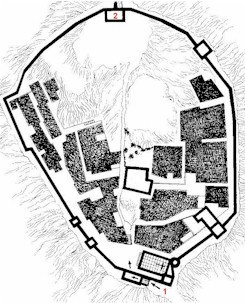|
The name of the town - from CASTRUM NOVUM to CHÂTEAUNEUF DU PAPE 1. Castrum Novum |
||
|
The first writen document
mentioning the existence of a community which can be identified being placed
on the spot of Chateauneuf du Pape today is from 1094. The document tells
about belongings to the bishop of Avignon and one of these belongings is
Castro (Castrum) Novo (Novum). It's a common assumption that this must be a kind of
birth certificate of Chateauneuf du Pape. Because the use of the word
Castrum it seems to have been a village with fortifications and not a
village with a castle (castellum). Castrum Novum must have been a "new" fortified town. There have of course lived people at the place before 1094. There have been found relicts from Roman time at several places in Chateauneuf and only 10 kilometres to the north is Orange with many well preserved Roman monuments. In 1146 Geoffrey Béranger, Viscount of Avignon in a document to the bishop of Avignon talks about Castrum Novum as built by one from his family. From this and other sources it's anticipated that a forthified village was built at the site between 1040 and 1073. It's almost certain there have been two churches in the town at that time. The parish church at the site for the church of today (on the slope) and the Saint Theodoric chapel, which is the oldest existing building of the town and placed in the lower part of the town (the parking place at Avenue Baron le Roy). Tomb stones found around the chapel indicates that its existence dates back to the Xth century. The drawing to the left is from "CHÂTEAUNEUF DU PAPE Mémoire d'un village" by Jean-Claude Portes. The main entrance is marked 1 and is very near the place of the church of today. The top of the hill is marked 2 and here is the site of the ruins of the castle today. The rempart to the right follows Rue Vieille Ville and to the left they are near Avenue des Oliviers. |
|
|
2. Chateauneuf Calcernier In 1213 Bertrand and Guillaume de Laudun pay homage to the bishop of Avignon for all they have in Lers and Chateauneuf Calcernier (Castronovo Calcernarium). Above is discussed the meaning of Castronovo. The word Calcernier is most probably added to distinguish the place from others of the same name. Calcernier means lime kilns. For centuries the town was known for it's fine lime, which for a long period was an important source of income for the people of the town. This name of the town was the official name for more than 600 years and thus it connected the town with a product of good quality like today's name of the town make people around the world think of good wine. 3. Chateauneuf Calcernier dit de Pape 4. Chateauneuf d'Avignon For a short time after 1789 - the revolution - was used the name Chateauneuf d'Avignon, but only for a couple of years. (1790-93) 5. 1893 Chateauneuf du Pape During the XVIII and XIX centuries the wines from the town became well known in France and abroad. The wines were known as the wines from Chateauneuf du Pape. Then the wine growers felt it was time to officially change the name of the town. The mayor Joseph Ducos ( the owner of La Nerthe ) took the initiative, and at last the town got its name of today. Many people think the name of the town refers to the "new" castle of the popes but the town was called Chateauneuf a long time before the castle was built. It's a mythe just as hard to kill as the mythe that it was the Germans who destroyed the castle in 1944. They did destroy the donjon, but the rest of the castle at that time was already a ruin. |
||
